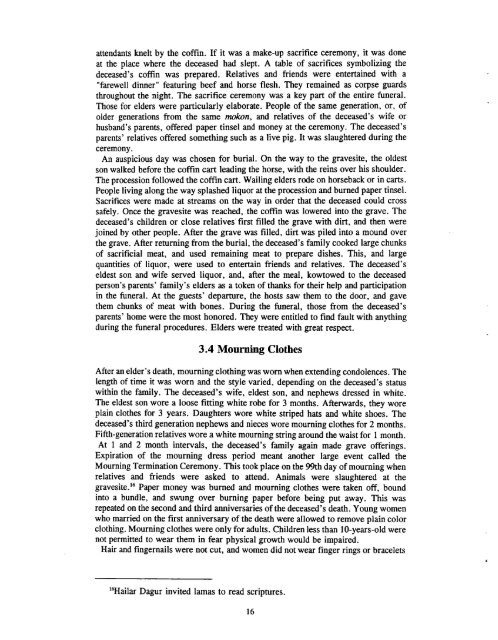China's Dagur Minority - Sino-Platonic Papers
China's Dagur Minority - Sino-Platonic Papers
China's Dagur Minority - Sino-Platonic Papers
You also want an ePaper? Increase the reach of your titles
YUMPU automatically turns print PDFs into web optimized ePapers that Google loves.
attendants knelt by the coffin. If it was a make-up sacrifice ceremony, it was doneat the place where the deceased had slept. A table of sacrifices symbolizing thedeceased's coffin was prepared. Relatives and friends were entertained with a"farewell dinner" featuring beef and horse flesh. They remained as corpse guardsthroughout the night. The sacrifice ceremony was a key part of the entire funeral.Those for elders were particularly elaborate. People of the same generation, or, ofolder generations from the same mkon, and relatives of the deceased's wife orhusband's parents, offered paper tinsel and money at the ceremony. The deceased'sparents' relatives offered something such as a live pig. It was slaughtered during theceremony.An auspicious day was chosen for burial. On the way to the gravesite, the oldestson walked before the coffin cart leading the horse, with the reins over his shoulder.The procession followed the coffin cart. Wailing elders rode on horseback or in carts.People living along the way splashed liquor at the procession and burned paper tinsel.Sacrifices were made at streams on the way in order that the deceased could crosssafely. Once the gravesite was reached, the coffin was lowered into the grave. Thedeceased's children or close relatives. first filled the grave with dirt, and then werejoined by other people. After the grave was filled, dirt was piled into a mound overthe gave. After returning from the burial, the deceased's family cooked large chunksof sacrificial meat, and used remaining meat to prepare dishes. This, and largequantities of liquor, were used to entertain friends and relatives. The deceased'seldest son and wife served liquor, and, after the meal, kowtowed to the deceasedperson's parents' family's elders as a token of thanks for their help and participationin the funeral. At the guests' departure, the hosts saw them to the door, and gavethem chunks of meat with bones. During the funeral, those from the deceased'sparents' home were the most honored. They were entitled to find fault with anythingduring the funeral procedures. Elders were treated with great respect.3.4 Mourning ClothesAfter an elder's death, mourning clothing was worn when extending condolences. Thelength of time it was worn and the style varied, depending on the deceased's statuswithin the family. The deceased's wife, eldest son, and nephews dressed in white.The eldest son wore a loose fitting white robe for 3 months. Afterwards, they woreplain clothes for 3 years. Daughters wore white striped hats and white shoes. Thedeceased's third generation nephews and nieces wore mourning clothes for 2 months.Fifth-generation relatives wore a white mourning string around the waist for 1 month.At 1 and 2 month intervals, the deceased's family again made grave offerings.Expiration of the mourning dress period meant another large event called theMourning Termination Ceremony. This took place on the 99th day of mourning whenrelatives and friends were asked to attend. Animals were slaughtered at thegravesite.16 Paper money was burned and mourning clothes were taken off, boundinto a bundle, and swung over burning paper before being put away. This wasrepeated on the second and third anniversaries of the deceased's death. Young womenwho married on the first anniversary of the death were allowed to remove plain colorclothing. Mourning clothes were only for adults. Children less than 10-years-old werenot permitted to wear them in fear physical growth would be impaired.Hair and fingernails were not cut, and women did not wear finger rings or bracelets16Hailar <strong>Dagur</strong> invited lamas to read scriptures.16
















